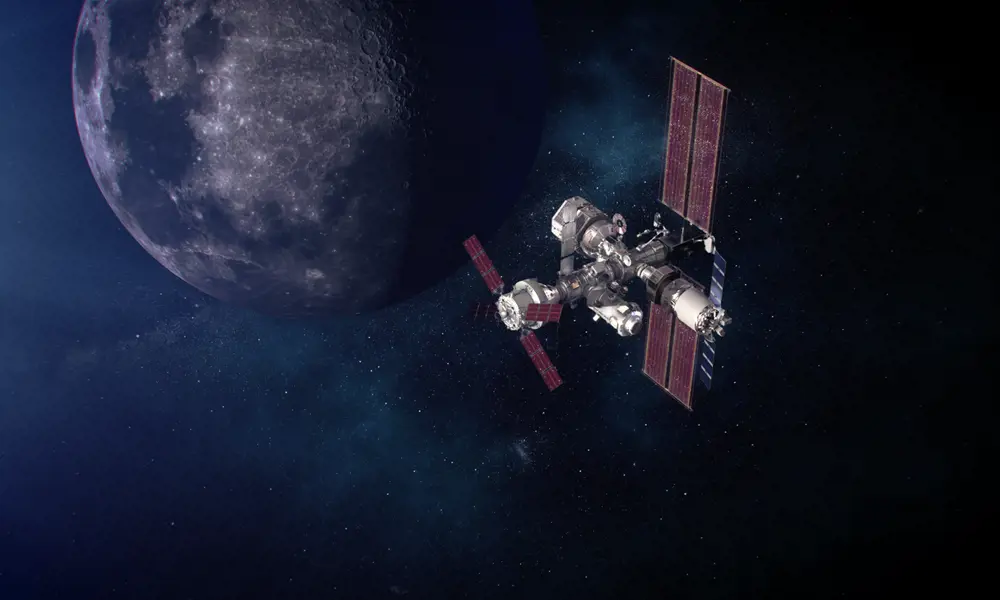
Lift-off for the UK's space industry
Did you know?
- Space isn’t just a gateway to the Moon, Mars and beyond. Having consistent access to space will also enable us to monitor climate change and protect critical national infrastructure, from ambulance networks to the electricity grid and banking systems
- In November 2022, the UK government committed £1.84 billion to new space programmes, including Earth observation and climate programmes
- There are already three spaceports in the UK, with more anticipated in locations such as Argyll and Snowdonia
According to the UK Space Agency, our thriving space industry generates an annual income of £17.5 billion and employs 48,800 people.
The majority of this industry is centred around satellite telecommunications, including television broadcasting via satellite and GNSS (global navigation satellite system) services. Space manufacturing and operations are smaller segments, but still worth over £3.7 billion combined. The former includes making satellites, launch vehicles, and other components and instruments. Counted among the latter are operating satellites and launch services.
While still a fledgling area, much has been made of the potential for satellite launches from UK spaceports in recent years. This is because UK satellites must currently be sent long distances for launch – not ideal for complex and sensitive equipment. They also compete for spots in busy launch schedules at spaceports abroad, against other national and commercial customers.
Three spaceports have been established in the UK so far – in Cornwall, Sutherland and the Shetland Isles – and more are in the works. The spaceports, mostly in remote locations for safety reasons, are an important addition to the UK’s large and growing space sector. Once these are up and running, UK satellites will have much greater flexibility to get to space when needed.
Three spaceports have been established in the UK so far – in Cornwall, Sutherland and the Shetland Isles – and more are in the works. Once these are up and running, UK satellites will have much greater flexibility to get to space when needed.
While the first attempted satellite launch from UK soil in Cornwall in January 2023 failed, more are scheduled. SaxaVord Spaceport at Unst in Shetland says its first launch is planned for the end of 2023. Meanwhile, the Civil Aviation Authority has granted over 340 licences to companies in the UK space sector since July 2021.
All this suggests the future is bright for the UK’s space industry. So, how did we get to this point?
The UK's history in space
“We are really good at telecommunications,” states Sarah Macken, Vice President for UK sales at Airbus Aerospace and Defence, the UK’s biggest spacecraft manufacturer, at its site in Stevenage. “It’s a really deep history that has evolved over 50 years. We got into that market very early on and have managed to maintain a position. We’ve done that by co-investing with government and through the ARTES programme [advanced research in telecommunications systems – the European Space Agency’s R&D programme for commercial telecommunication products and services].”
Macken believes that one of the UK’s most important specialisms in satellite manufacture is signal processing. Signal processing circuitry is embedded all around the satellite and includes subsystems that boost the signal and transport it around the satellite. “We’ve been at the forefront of developing that from the analogue into the digital era. [Digital signal handling] allows a lot more flexibility in how satellites are operated. Today, satellites can be reprogrammed and moved to a new location. In the analogue days, you would put it up there and that was it. That is no longer the case. The UK was successful at the start of that trend, and it is still there today.”
[Digital signal handling] allows a lot more flexibility in how satellites are operated. Today, satellites can be reprogrammed and moved to a new location. In the analogue days, you would put it up there and that was it. That is no longer the case.
Sarah Macken, Airbus Aerospace and Defence
According to Macken, while people often associate electronics manufacturing with East Asia, commercial electronics and programming are in fact big UK successes – particularly for the space sector. “We supply about 25% of the world’s satellite communications products, which is a huge proportion,” she says, referring to electronic components from whole satellites all the way down to individual subsystems such as those for signal processing mentioned previously.
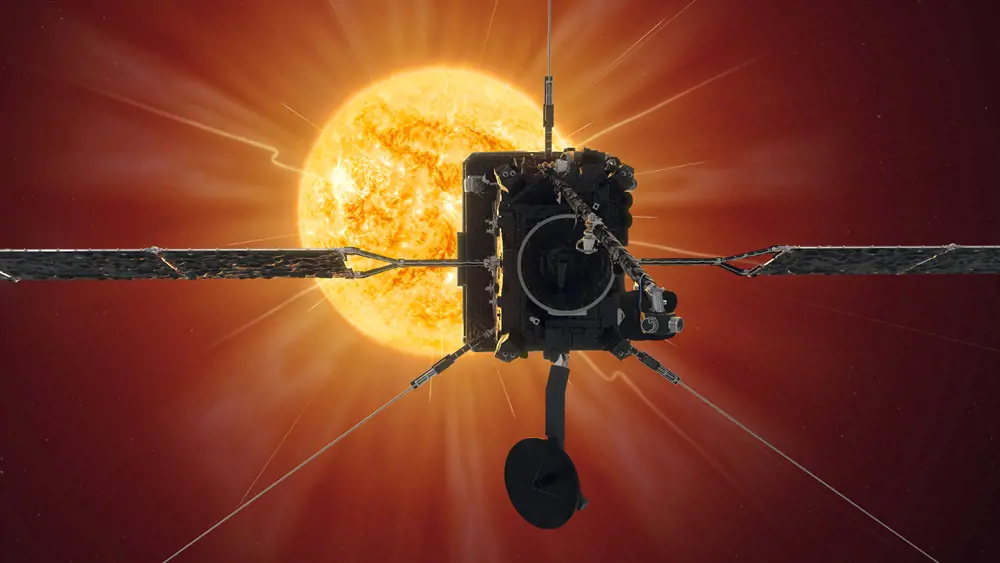
The Solar Orbiter reaches first perihelion – the point at which it is closest to the Sun © ESA Medialab
Exploring new worlds
The UK has also played a significant role in space science missions. Macken says that 2020’s Solar Orbiter mission was a particular highlight. This European Space Agency (ESA) satellite was launched to take images of the Sun closer than any other spacecraft. “It was led by the UK: we did the design; we came up with a solution to the problem of how you operate so close to the Sun.” The data it collects advances our knowledge of the Sun, as well as feeding into climate models.
Further afield, the ExoMars mission is Europe’s attempt to uncover whether life has ever existed on Mars. It’s set to launch in 2028 after many delays, including one caused by the invasion of Ukraine. The UK led the development of the ExoMars Rover, named Rosalind Franklin.
“Our experience on that project will lead into the lunar economy, where we are seeing growing interest,” says Macken. “At the most recent ESA ministerial meeting, a new programme was funded to develop lunar communications and navigations in a project called Moonlight, which is really exciting.”
This is linked to NASA’s Artemis programme, of which ESA is a key partner. That programme aims to return people to the Moon by the end of the decade and will hinge on reliable and autonomous lunar communications and navigation services.
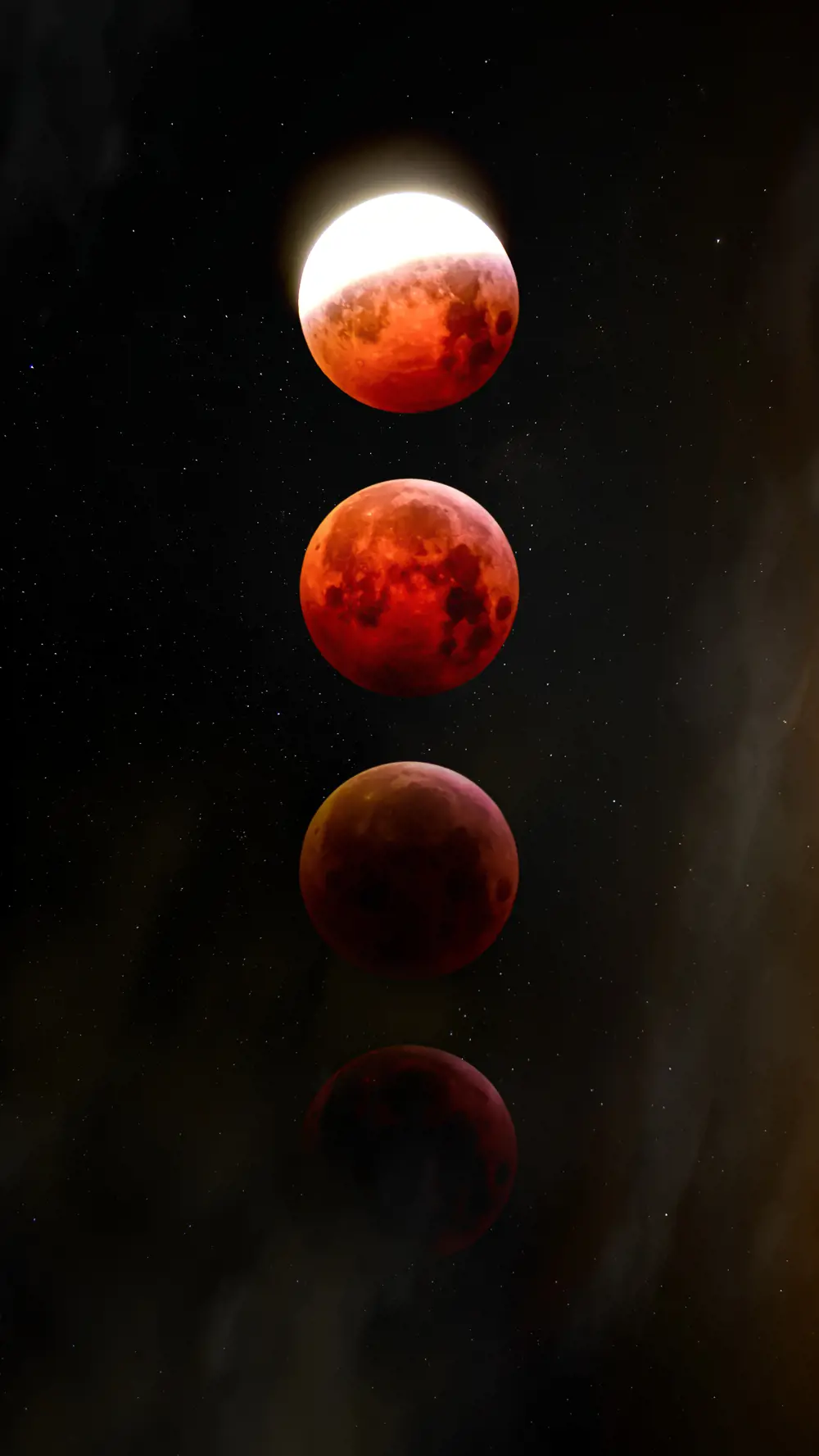
© Zoltan Tasi / Unsplash
The Moonlight project aims to send three or four satellites into lunar orbit by space tug. This transfers spaceborne cargo from one orbit to another orbit with different energy characteristics. The tug will deploy satellites one by one, to form a constellation of lunar satellites. Engineers have optimised the constellation’s orbits to cover the lunar south pole.
This area is the focus of upcoming missions for two reasons. Firstly, certain regions of the south pole have year-round sunlight. This is important for solar-powered equipment, as days and nights in other lunar areas can be two weeks long. The presence of polar ice is also a huge plus, as water is key for long-term exploration. Moonlight’s plan is to provide sufficient satellite communications capacity for future missions, alongside accurate real-time positioning for lunar missions.
Airbus also built a rover at its Stevenage site for NASA and ESA’s joint Mars sample return mission. Scheduled for the 2030s, this was designed to collect samples of Martian soil and rock cached by NASA’s Perseverance rover, which landed on Mars in 2021. However, in July 2022, the agencies abandoned the fetch rover concept in favour of using two small helicopters. Despite this setback, Airbus has been testing its fetch rover in a quarry near London and hopes that it may be used on a future lunar mission.
Abbie Hutty, a systems engineer who worked on the fetch rover at Airbus, now works for Japanese space company iSpace in Luxembourg. Like her former employer, she has switched her attention from Mars to the Moon. The UK’s record in developing rovers helped to make Hutty an attractive proposition for iSpace. “The UK is the only European country that has led rover projects in recent years. If you’re looking at surface operations, we have a lot of competence that other countries cannot compete with. That meant that I had a very competitive skillset.”
Building partnerships
The UK is also home to smaller companies involved in space. Over 100 space organisations with more than 1,400 employees are based at the Harwell Campus just outside Oxford. Countless startups sit alongside hubs of larger players such as Airbus, Lockheed Martin, the UK Space Agency, and ESA. For example, Astroscale is developing services to remove hazardous space debris, while Oxford Space Systems manufactures satellite hardware.
Leicester is also a space hub, thanks to the UK National Space Centre. This museum and educational resource is twinned with a space research programme, in partnership with University of Leicester.
Over 100 space organisations with more than 1,400 employees are based at the Harwell Campus just outside Oxford. Countless startups sit alongside hubs of larger players such as Airbus, Lockheed Martin, the UK Space Agency, and ESA.
“The University of Leicester has had a continuous research programme starting with rockets, graduating to satellites and expanding into planetary science and Earth observation,” explains Martin Barstow, professor of astrophysics and space science at the university and Director of Strategic Partnerships at Space Park Leicester (SPL).
The intention with SPL, he explains, was to bring academic and industrial partners together under one roof with laboratories and a large ISO-6 rated cleanroom. “For small companies, often one of the big challenges is investing in expensive infrastructure, which they might only need on an intermittent basis,” he adds. “Our shared facilities help them avoid that challenge.”
Currently, 25 companies use SPL’s facilities. “A lot of our activities include building things to fly in space, particularly instruments for space research, planetary exploration, astrophysics, Earth observation, and that’s essentially our heritage,” Barstow says. “Equally, we have a similar volume of people who are into the use of data from those instruments, the downstream and spin-off activities that move out into industry.”

Earth observation imagery of Jebel Kissu, in northwestern Sudan. The bright linear features are truck tracks, common in the Sahara where there are no paved roads. © Unsplash / USGS
Solving problems on Earth with a bird’s eye view
Earth observation is used for many things, but perhaps its most important application is protecting our planet. Copernicus, operated by the EU, is the world’s largest Earth observation programme, and its Climate Change Service provides important data on climate change, from monitoring glaciers to collecting data on droughts.
Looking to a smaller scale, UK startup Rezatec, also based at Harwell Campus, have helped water utilities identify pollution sources. Its approach uses machine learning techniques to analyse satellite images, looking at things such as the types of crops, land topography, and the hydrology (the way water is distributed on land).
For example, to analyse the types of crops over a land area, their engineers fed vast volumes of data into its crop ID model, training it to recognise the ‘signature’ of specific crops with over 97% accuracy. This was used to estimate fertiliser application and fed into a model to map risk to water sources from particular crop fields.
Read more in Ingenia 77.
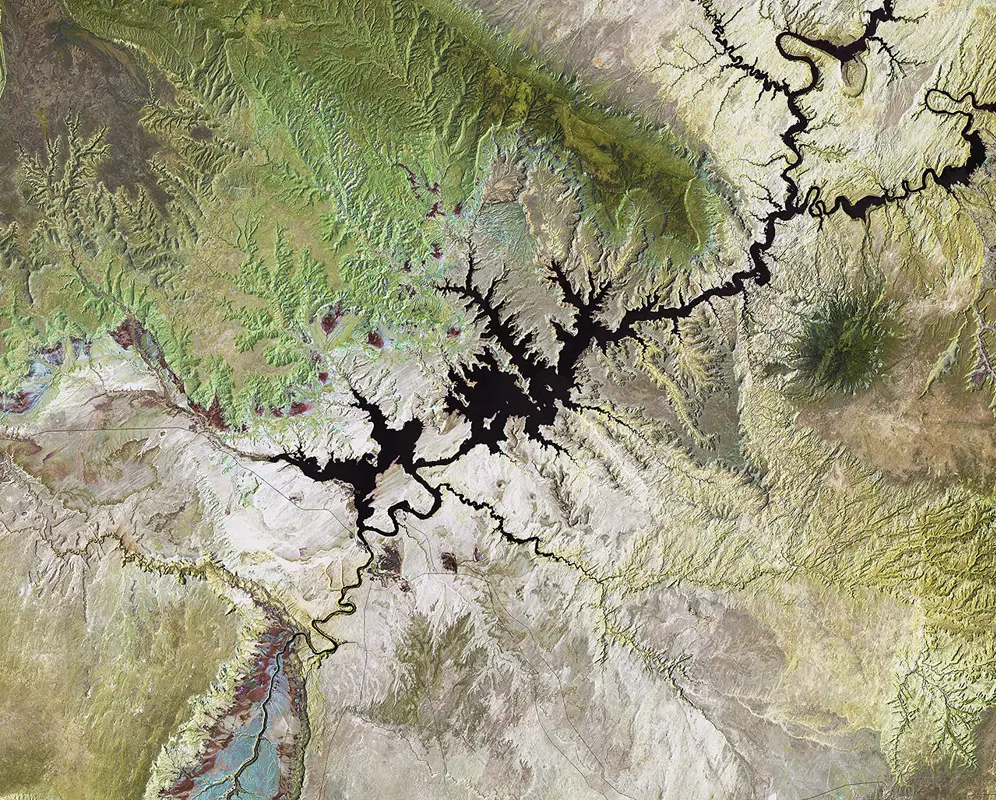
Earth observation photo of Lake Powell in the US
He explains that space-developed technologies can also become very valuable to areas like medicine or agriculture. One example of this is Earth observation. In such missions, satellites gather data about the planet’s physical, chemical and biological systems via remote sensing technologies, which is then used to monitor and assess changes in Earth’s natural and built environments (see box ‘Solving problems on Earth with a bird’s eye view’; also ‘The evolution of Earth observation’, Ingenia 77).
Lifting off
According to Matt Archer, Director of Commercial Spaceflight at the UK Space Agency, spaceports will also become an important part of the UK’s space industry (‘The final frontier’, Ingenia 82). Spaceport Cornwall will only host horizontal launches — those from adapted conventional aircraft such as Cosmic Girl, the Boeing 747 used by Virgin Orbit. This is because the safety case for horizontal launch is essentially the same as an airport, as the launch itself doesn’t happen on the ground. More of a risk surrounds the propellants used for launch when it takes place from the ground, as in vertical launches.
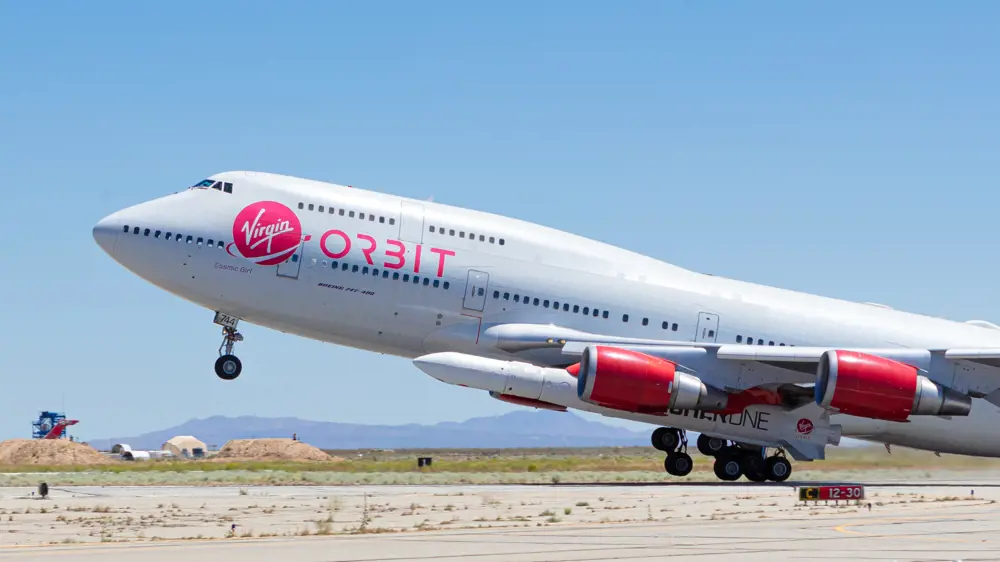
© Virgin Orbit
However, two sites equipped for vertical launch aim to begin operations in Scotland in 2023. One is in Sutherland on the A’Moine peninsula; the other is even further north at Lamba Ness on the island of Unst in the Shetlands.
Orbex will operate the Sutherland site. The Scottish company is developing a small commercial launch vehicle that is designed to be reusable. It has a 3D-printed engine, with its main structures and tanks composed from advanced carbon fibre and graphene composites.
Meanwhile, the spaceport on Shetland’s isle of Unst, SaxaVord, will host launches from a variety of commercial operations. It has already announced partnerships with German launch operations provider Rocket Factory Augsburg and US firm ABL Space Systems, while Lockheed Martin is to build a satellite tracking and communications station.
Missions from UK spaceports are likely to be different from those launched from more familiar established launch locations, such as NASA’s Cape Canaveral or the ESA’s Kourou site in French Guiana. “Launch sites near the Equator use the rotation of the Earth to boost launch velocity, and you can reach Equatorial orbits with ease,” Archer explains. “If you launch from higher latitudes, you don’t get that boost, but it does allow you access to orbits that are difficult to reach if you launch from the Equator. Our advantage is in reaching polar and sun-synchronous orbits, which are actually very useful for telecommunications satellites and Earth observation missions.”
Cleaning up in space
With the ever-increasing array of satellites launched into orbit, what about the concerns about the Earth’s orbits becoming congested with ‘space junk’?
Thankfully, work is underway to tackle this problem. The groundwork was laid in 2019, by a consortium led by the University of Surrey, with several partners including Airbus. Its RemoveDEBRIS spacecraft (In Brief, Ingenia 77) involved a vision-based navigation system that validated debris-tracking techniques in orbit with cameras and LIDAR, along with a net and harpoon to actually capture space junk. Successful testing took place in 2019.
Meanwhile, Harwell Campus-based startup Astroscale recently announced that its debris removal service is on track to remove two defunct satellites by 2026 using a robotic capture system.
Sun-synchronous orbits travel over both poles regularly, often multiple times per day. They allow satellites to take pictures of the same part of the Earth on the same part of each day. “You might want to take a bunch of Earth observation images of the UK during the day at a particular time,” Archer adds. “You’d use a sun-synchronous orbit for that. The Scottish spaceports will specialise in those sort of launches, while Cornwall will be able to handle a wider range of orbits because the aircraft can fly to different latitudes to release its launcher.”
Looking further ahead still, in the same way that NASA has shown how large missions can capture the imagination, so could the idea of putting large arrays of photovoltaic panels in orbit to send energy down in microwave-form to the Earth. This approach, space-based solar power, could help us to decarbonise the energy supply. It may provide huge opportunities for the UK space industry in the coming decade and beyond.
Such grandiose plans are, of course, for the future. But the fact remains that the UK is a major player in space. Without input from UK industry, much of the world’s vital communications infrastructure would not exist, and the industries that depend on it, including media and finance, would suffer. In fact, a 2022 report from industry consultancy Technopolis on behalf of the UK Space Agency found that every pound invested in the UK space industry generates a return for the UK economy of £11.80. There aren’t many industries that can boast such a multiplier.
***
Stuart Nathan thanks Sarah Macken, Vice President for UK sales at Airbus Aerospace and Defence; Abbie Hutty, Lead Systems Engineer, iSpace; Martin Barstow, professor of astrophysics and space science at the University of Leicester and Director of Strategic Partnerships at Space Park Leicester; and Matt Archer, Director of Commercial Spaceflight at the UK Space Agency.
***
This article has been adapted from "Lift off for space in the UK", which originally appeared in the print edition of Ingenia 95 (June 2023).
Contributors
Stuart Nathan
Author
Keep up-to-date with Ingenia for free
SubscribeRelated content
Aerospace
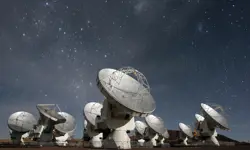
ALMA – the high altitude observatory
The Atacama Large Millimetre/submillimetre Array (ALMA) is the largest and most expensive ground-based telescope built, revolutionising our understanding of stars and planetary systems. Building it in the Atacama Desert in Chile required the ingenuity of hundreds of engineers.
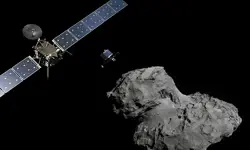
Communicating with outer space
The Royal Academy of Engineering awarded a team at BAE Systems the Major Project Award in June 2016 for their development of a powerful satellite modem system, pivotal in enabling the precise control of the pioneering Rosetta spacecraft and the first-ever soft landing of a spacecraft on a comet.
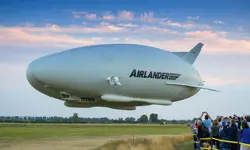
An aircraft like no other
The Airlander made headlines when it embarked on its first test flight in August 2016 as the world’s largest aircraft. Chris Daniels at Hybrid Air Vehicles Limited, and David Burns, Airlander’s Chief Test Pilot, talk about the engineering that helped it reach this stage and plans for the craft’s future.

Q&A: Lucy Harden
Lucy Harden is a mechanical engineer on BAE Systems’ Digital Light Engine Head-Up Display development programme. She devises innovative solutions for pilots to display essential flight information that sits directly in their line of sight and is overlaid onto the real world.
Other content from Ingenia
Quick read

- Environment & sustainability
- Opinion
A young engineer’s perspective on the good, the bad and the ugly of COP27

- Environment & sustainability
- Issue 95
How do we pay for net zero technologies?
Quick read

- Transport
- Mechanical
- How I got here
Electrifying trains and STEMAZING outreach

- Civil & structural
- Environment & sustainability
- Issue 95